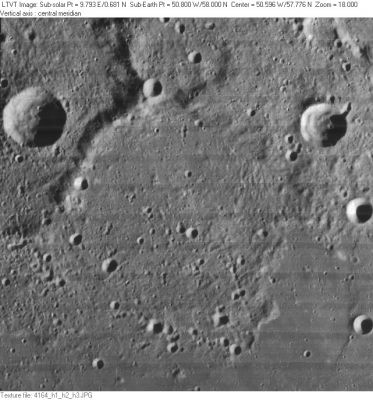Difference between revisions of "South"
| Line 6: | Line 6: | ||
|} | |} | ||
<div id="toc"> | <div id="toc"> | ||
| − | + | [http://www.lpod.org/coppermine/albums/userpics/South_LO-IV-164H_LTVT.JPG [[Image:normal_South_LO-IV-164H_LTVT.JPG|external image normal_South_LO-IV-164H_LTVT.JPG]]]<br /> ''[http://lpod.org/coppermine/displayimage.php?pos=-2495 LO-IV-164H]'' '''South''' is the vaguely bounded region of rough terrain in the center of the frame. To its upper right is 24-km [http://the-moon.us/wiki/Robinson Robinson], and to the upper left a small part of 143-km [http://the-moon.us/wiki/Babbage Babbage] with 14 km '''[http://the-moon.us/wiki/Babbage Babbage] C''' on its floor.<br /> <br /> | |
| − | |||
==Images== | ==Images== | ||
[http://www.lpod.org/coppermine/thumbnails.php?album=search&type=full&search=South LPOD Photo Gallery] [http://www.lpi.usra.edu/resources/lunar_orbiter/bin/srch_nam.shtml?South%7C0 Lunar Orbiter Images]<br /> <br /> | [http://www.lpod.org/coppermine/thumbnails.php?album=search&type=full&search=South LPOD Photo Gallery] [http://www.lpi.usra.edu/resources/lunar_orbiter/bin/srch_nam.shtml?South%7C0 Lunar Orbiter Images]<br /> <br /> | ||
| Line 22: | Line 21: | ||
* Westfall, 2000: 0.97 km | * Westfall, 2000: 0.97 km | ||
* Cherrington, 1969: 1.58 km | * Cherrington, 1969: 1.58 km | ||
| − | <br /> '''The red spot in South'''<br /> - Small reddish spot in '''South''', observed by Maw on 15th June 1913. Source: V.A.Firsoff's ''The Old Moon and the New'' (1969), page 185.<span class="membersnap">- | + | <br /> '''The red spot in South'''<br /> - Small reddish spot in '''South''', observed by Maw on 15th June 1913. Source: V.A.Firsoff's ''The Old Moon and the New'' (1969), page 185.<span class="membersnap">- DannyCaes <small>May 19, 2012</small></span><br /> - At the northwest end of '''South''' is a rugged plateau, on this Dr. W.H.Maw saw on 1913, June 15, when the plateau was on the terminator, a distinct small reddish spot, which became diffused into a patch as the terminator advanced. Source: Walter Goodacre's APPENDIX in T.W.Webb's ''Celestial Objects for Common Telescopes'' (''Volume 1: The Solar System''), page 163.<span class="membersnap">- DannyCaes <small>May 20, 2012</small></span><br /> <br /> |
==Nomenclature== | ==Nomenclature== | ||
| Line 37: | Line 36: | ||
<br /> <br /> | <br /> <br /> | ||
---- | ---- | ||
| − | + | </div> | |
Revision as of 16:52, 15 April 2018
Contents
South
|
Lat: 58.0°N, Long: 50.8°W, Diam: 104 km, Depth: 0.97 km, Rükl: 2, pre-Nectarian |
LO-IV-164H South is the vaguely bounded region of rough terrain in the center of the frame. To its upper right is 24-km Robinson, and to the upper left a small part of 143-km Babbage with 14 km Babbage C on its floor.
Images
LPOD Photo Gallery Lunar Orbiter Images
Maps
(LAC zone 10B3) USGS Digital Atlas PDF
Description
Description: Elger
(IAU Directions) SOUTH.--On the E. and S., the boundaries of this extensive enclosure are merely indicated by ridges, which nowhere attain the dignity of a wall. On the N., the edge of a tableland intersected by a number of valleys define its limits, and on the W. a border forming also the E. side of Babbage. The interior is traversed by a number of longitudinal hills, and includes two bright little heights, drawn by Schmidt as craters.
Description: Wikipedia
Additional Information
Depth data from Kurt Fisher database
- Westfall, 2000: 0.97 km
- Cherrington, 1969: 1.58 km
The red spot in South
- Small reddish spot in South, observed by Maw on 15th June 1913. Source: V.A.Firsoff's The Old Moon and the New (1969), page 185.- DannyCaes May 19, 2012
- At the northwest end of South is a rugged plateau, on this Dr. W.H.Maw saw on 1913, June 15, when the plateau was on the terminator, a distinct small reddish spot, which became diffused into a patch as the terminator advanced. Source: Walter Goodacre's APPENDIX in T.W.Webb's Celestial Objects for Common Telescopes (Volume 1: The Solar System), page 163.- DannyCaes May 20, 2012
Nomenclature
- Named for James South(1785-1867), a British astronomer .
- The name was introduced by W. R. Birt in 1862-3.
- This feature is Catalog number 1706 in Mary Blagg's Collated List, where it is noted as being named only in Neison, 1876.
- The name (attributed to Birt) was added to the IAU nomenclature in Named Lunar Formations.
LPOD Articles
Bibliography
- Birt, W. R. 1863. "On a Group of Lunar Craters imperfectly represented in Lunar Maps." Report of the British Association for the Advancement of Science 1862 Meeting. Notices Section (at end), pp. 9-12.
